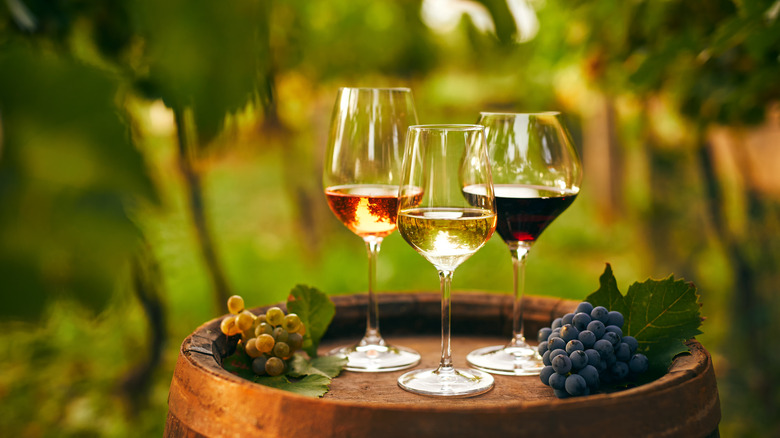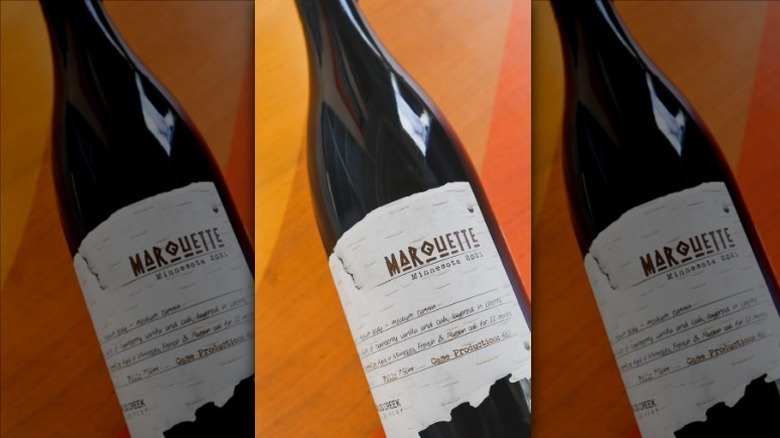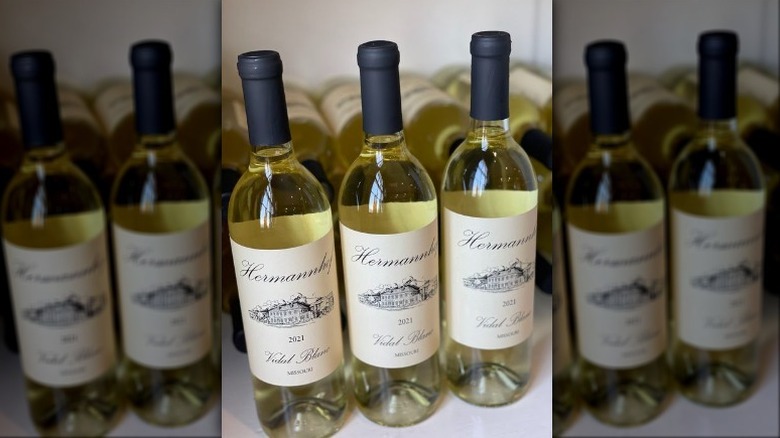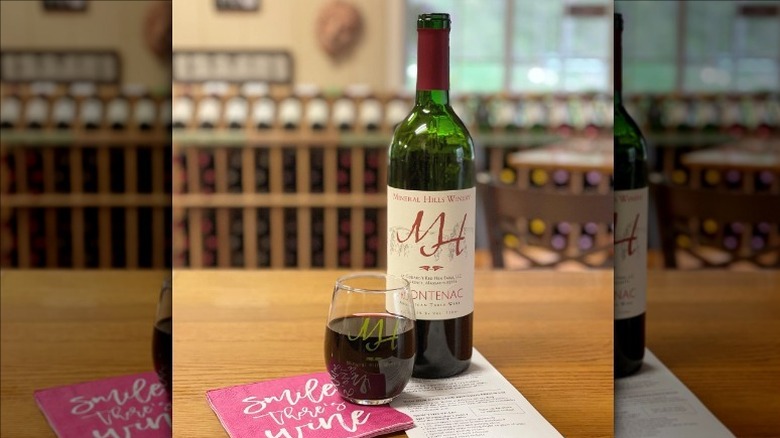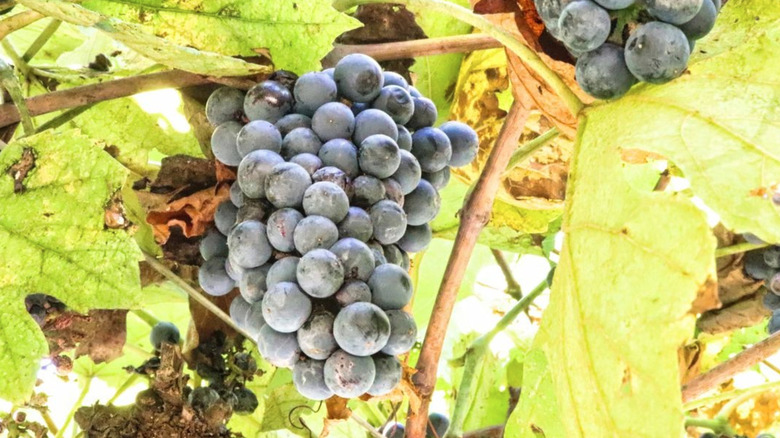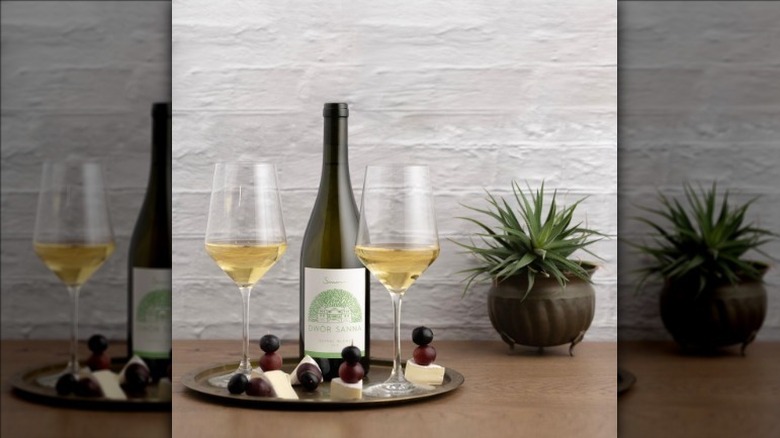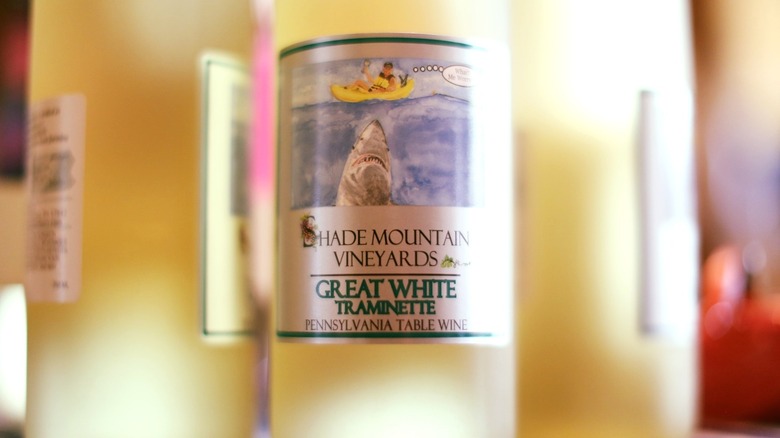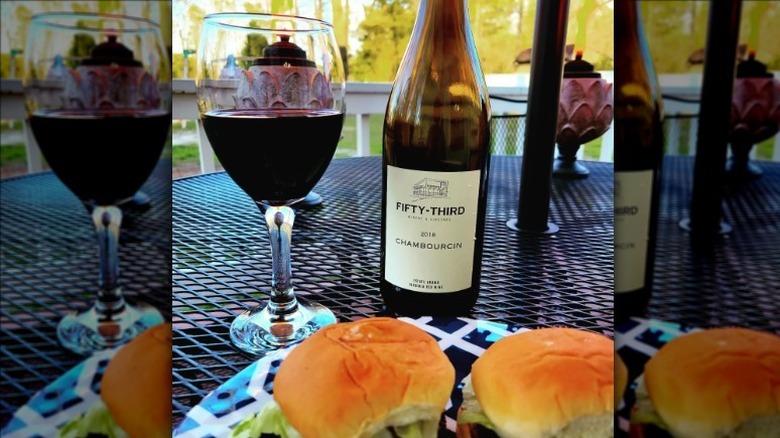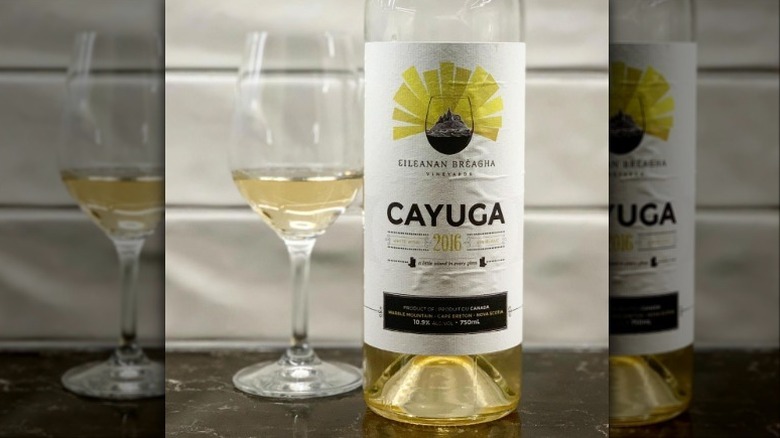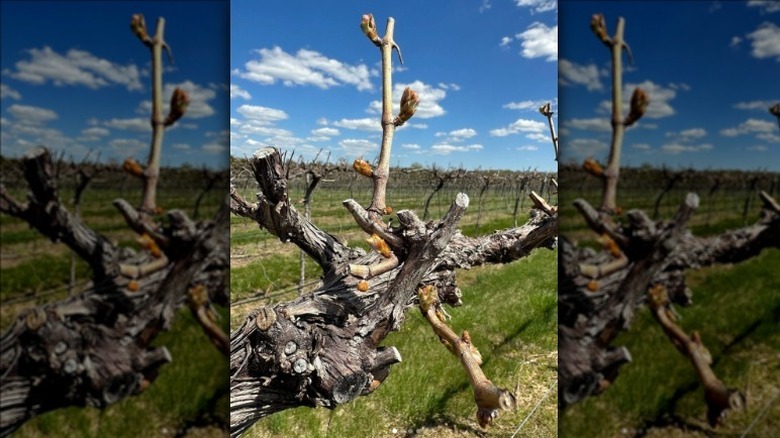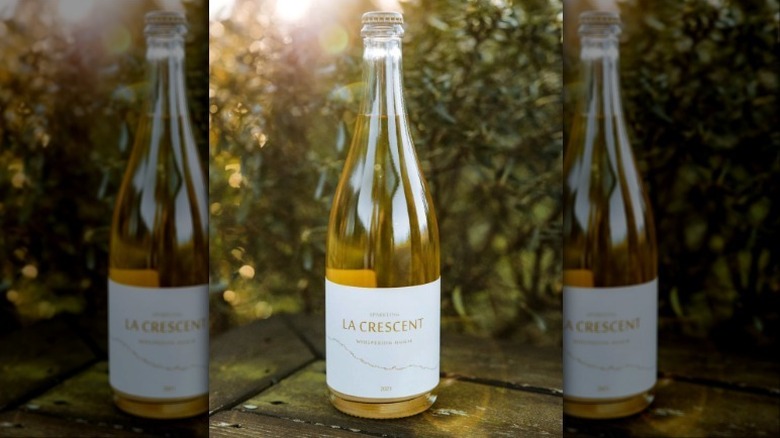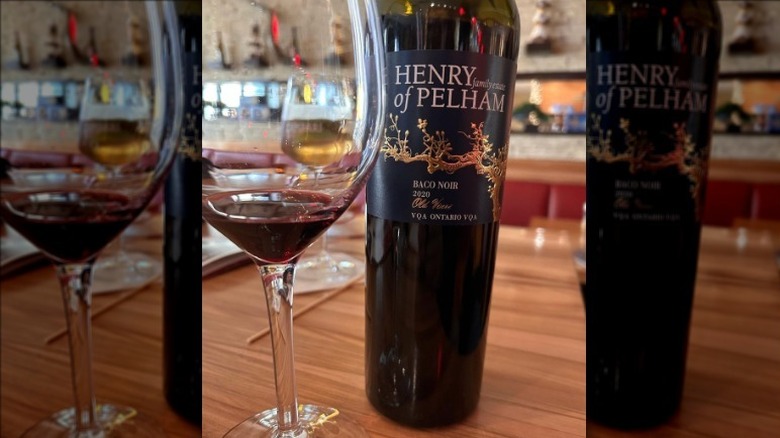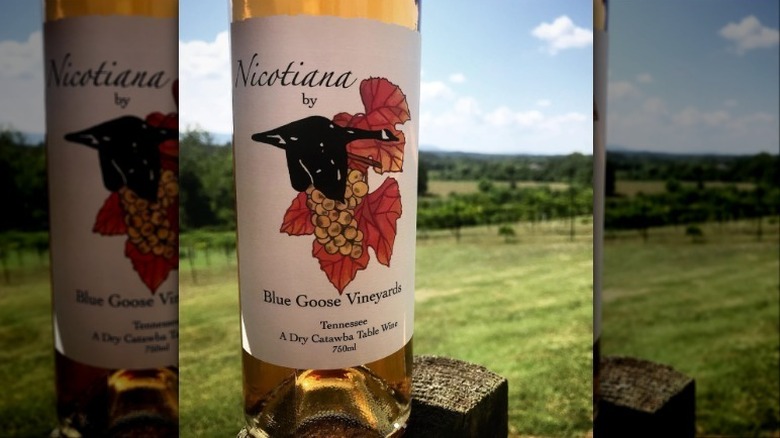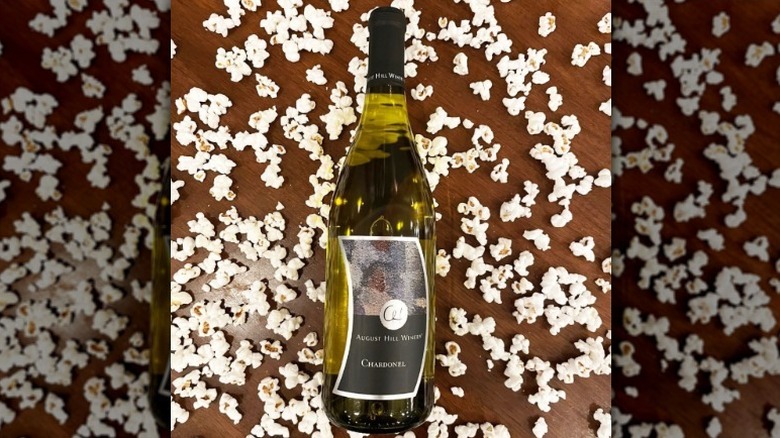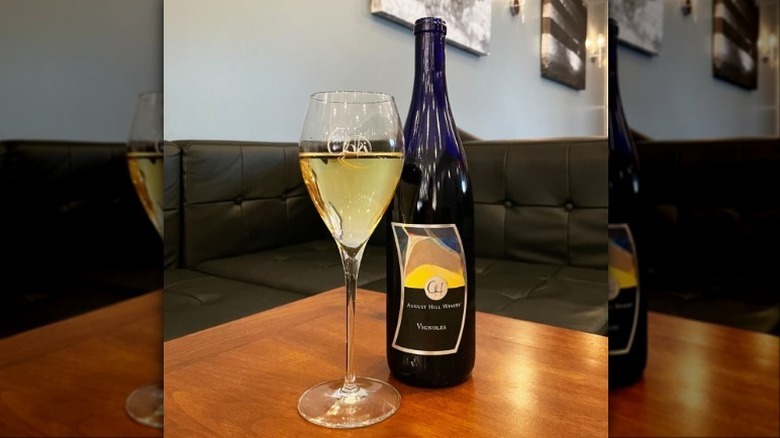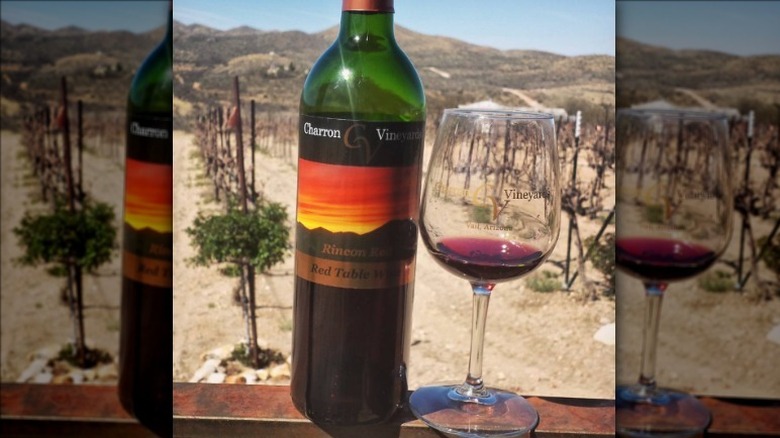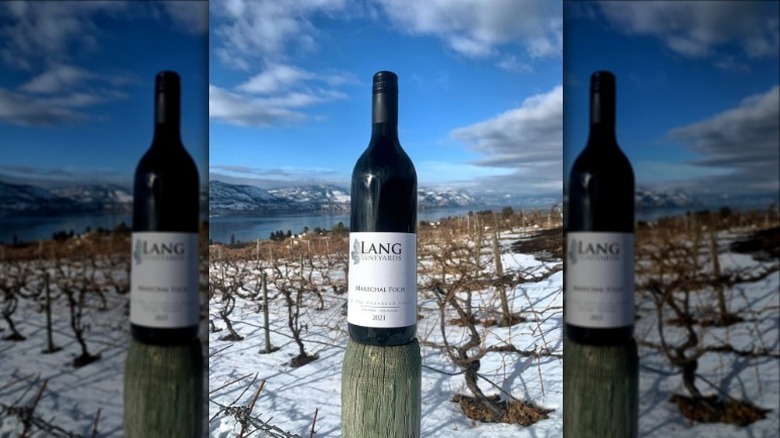16 Types Of Hybrid Wine Grapes You Should Know About
It's no secret that the drastic effects of climate change are already affecting people all over the globe. Not only are we now suffering from catastrophic weather events and wildfires, but our food supply will be affected as well. And while that may spell trouble for everyday crops like bananas and Brussels sprouts, it's coming for the wine industry too. Warmer-than-average temperatures can affect the flavor and ripeness of the grapes used to make wines, which means long-standing wine regions may not be able to produce the grapes they've grown for hundreds of years. More and more grape growers and enologists are starting to question how they're going to ensure the future success of their vineyards. One solution more progressive winemakers are turning to is hybrid grapes.
Hybrid grapes have parent vines from two different species. Generally, one of these vines will be Vitis vinifera, which is the species that produces the vast majority of wine you've ever tried. The other will often be an American species. When the two species are crossed, it often results in grapevines that are more weather-tolerant than traditional Vitis vinifera plants.
Wine made from hybrid grapes can be difficult to find if you don't know where to look. A natural wine store is a good start, but you can check online if you don't have access to specialty shops in your area. Let's take a closer look at some of the grapes you may encounter as you expand your hybrid wine horizons.
1. Marquette
Red grapes can be difficult to grow in cold-weather climates, which is why the University of Minnesota bred Marquette, the grandson of pinot noir. This grape can grow especially well in colder temperatures, which makes it a popular choice for winemakers growing grapes in the cold weather of the Northeast. If you manage to score a bottle of Marquette, you can expect a medium-bodied wine with notes of red and black cherry, sometimes with a hint of spice.
Some winemakers have tried aging Marquette with oak, which it seems to stand up to well. When it's been oaked, tobacco and leather notes can come to the fore. If you're already a fan of pinot noir, there's a good chance that you'll probably enjoy what Marquette has to offer as well.
2. Vidal Blanc
Vidal blanc was introduced to the world long before the climate crisis was an issue we thought about on the daily. Jean Louis Vidal created it for the production of cognac back in the 1930s. However, you won't find the grape in France anymore — it's not accepted for wine production in the country these days.
But just because you won't find Vidal blanc in France doesn't mean it's no longer around. It made its way to North America. In the U.S., it's often planted in northern states like New York, Michigan, and Rhode Island, and it can be found in Canada as well. Vidal blanc is often used in the production of sweet wines called icewine, which is made by harvesting the grapes after they've frozen on the vine. However, the grape can also be used to make dry white wines.
3. Frontenac
Frontenac is another of the University of Minnesota's inventions, and it was introduced in 1996. This is one of the first grapes that prompted Northern states to experiment with hybrids—states like Iowa, Wisconsin, and Michigan slowly started planting frontenac with positive results. As you can guess by where it's often planted, frontenac, like Marquette, is a black cold-hardy grape that can be grown in lower temperatures than the vast majority of black Vitis vinifera grapes.
These wines are typically quite acidic but with low tannins, which is the component in wine that makes your mouth feel dry. It can be used to make several different styles of wine, from dry reds, which are often oaked, to rosés. It's also popular in the production of port, a sweet red wine that originally hails from Portugal.
4. Norton
Norton has a special place amongst hybrid grapes because it's known as the oldest American native grape. After Europeans invaded the Americas, they wanted to make sure they had plenty of wine to drink, which started the scramble to search for an American wine grape. Norton, which was cultivated in Virginia, was the result.
Although some hybrid grapes have a less-than-favorable reputation amongst wine lovers, Norton is generally considered one of the best of the bunch when it comes to flavor since it closely mimics black grape varieties grown in Europe. Wines made with Norton grapes can be medium- or full-bodied and typically display notes of red fruit, like strawberries, red cherries, and raspberries. You'll find wine growers planting Norton in Texas, Missouri, Kansas, and Virginia, of course.
5. Seyval Blanc
It was a horticulturist named Bertille Seyve and his father-in-law, Victor Villard, who created Seyval blanc, which is, as the name suggests, a green-skinned grape that makes white wine. The grape is widely used in England where it's blended with other grapes to make sparkling wine, but you can also find it in the U.S. in colder climates. Because of its early-ripening tendencies, it does well in these colder regions, like the Finger Lakes of New York. Unfortunately, in the EU, it is not a permitted wine-making variety.
Some compare Seyval blanc to chardonnay since it has a similar flavor profile and relatively high acidity. Also like chardonnay, Seyval blanc takes well to malolactic fermentation, which rounds out the flavors and creates more balanced acidity.
6. Traminette
Gewurztraminer is a favorite for those who love aromatic white wine, but if you're looking for a wine made with hybrid grapes that has similar qualities, you may want to look to traminette, a variety cultivated at the University of Illinois in 1965. Like Gewurztraminer, you may pick up on some floral and tropical, melon-adjacent flavors in traminette, and it often boasts a hint of spice as well. Also like its parent, it can be made into both dry and off-dry styles. (Off-dry wines have a subtle sweetness to them.) Sometimes, it's used for the production of sparkling wine.
When this grape was originally cultivated, it was destined for table grape status — at first, these grapes were meant to be eaten, not turned into wine. But soon, winemakers discovered the potential of this hybrid and started making wine with it.
7. Chambourcin
Even though chambourcin, a black grape used to produce red wine, hails from France, these days, you're more likely to see it in the U.S. and Australia where it's used to make wines with black fruit characteristics and a decidedly vegetal aroma. In the U.S., it's common for winemakers to use these grapes in areas where other black grapes can't grow. In Australia, though, it's often blended with shiraz, where it provides a deeper color to the wine.
If you do taste chambourcin in France, it's probably going to be from the Loire, and it's likely to be included in a blend for a table wine since the grape is not approved to create higher-quality wines. Occasionally, it can be used to produce sparkling red wines.
8. Cayuga
Wondering where you can get your hands on some wine made from the Cayuga grape? Your best bet is going to be in the Finger Lakes in New York state where the cold temperatures provide the ideal growing environment for the cool-weather grape. One of its parents is the previously mentioned and relatively highly-regarded Seyval blanc grape, so it shouldn't come as a surprise that Cayuga is one of the more accepted hybrid varieties out there.
It's a versatile grape, which means it can be used to make a wide array of white wines, from still dry wines to sparkling numbers to sweet wines. In this last case, the grapes are allowed to hang out on the vine until they start to shrivel, which concentrates their sugars and flavors.
9. Cabernet doré
Cabernet doré is not an especially widely planted hybrid grape variety, but if you do get the chance to taste a wine made from it, you may recognize a familiar flavor. Many compare the grape to sauvignon blanc because it produces a similar light, aromatic, high-acid wine. It makes sense that the two grapes taste similar because one of cabernet doré's parents is cabernet sauvignon, which was bread from the sauvignon blanc grape.
Like many of the wines in this list, it does well in cooler climates than many of its Vitis vinifera counterparts. Grape growers have found that the vine grows similarly to that of its grandparent, sauvignon blanc. The grape was cultivated in Davis, California, and it came onto the scene in 2001.
10. La crescent
Looking for another interesting white wine grape? You may want to seek out wine made from la crescent, which was also created by the University of Minnesota in 2002. (Fun fact: It was actually named after a town in Minnesota.) You've probably noticed a theme here: Most grapes cultivated at the University of Minnesota are cold-tolerant, and that's certainly the case for la crescent, which can survive especially cold temperatures.
However, it generally doesn't make the best dry wines. Often, it's used to make sweet and off-dry wines. It doesn't hold onto as much acidity as other white wine varieties, which can make it feel flabby and uninteresting to those who prefer bracing, higher-acid whites. Take a sip from a wine made from la crescent grapes, and you may notice notes of tropical fruits and stone fruits, like peaches and nectarines.
11. Baco noir
Many of the hybrid grapes you've read about in this list are bred within the last few decades in the U.S., but that's not the case for Baco noir, which was created all the way back in 1894. François Baco was trying to create a phylloxera-resistant plant that could revive Europe's pandemic-struck vineyards. (An outbreak of phylloxera, a disease that affects grape vines, all but destroyed European wine production in the mid-1800s.) Since American vines are resistant to the disease, Baco thought that breeding a French-American hybrid could solve the phylloxera problem.
It was grown for a time in France, but now, it's found its home in North America. It's grown most prominently in New York State and Ontario, Canada, but it can be found throughout the continent. It's somewhat similar to pinot noir, with bright acidity and light body.
12. Catawba
If you're looking for a hybrid grape with some history attached, Catawba may be a solid choice. It's one of the first hybrid grapes used for wine production in the U.S. Nicholas Longworth used Catawba grapes to make sparkling wine in Ohio starting in 1813, quickly cementing himself as one of the first icons of American winemaking. However, Longworth's Catawba vines didn't last forever — in the 1860s, they fell victim to disease that wiped them out.
These days, Catawba is largely used to make still rosé wine that's not dissimilar to white zinfandel. It can also be used to make sparkling rosé. However, the wine made from Catawba grapes is often described as "foxy," which means it sometimes has an animal-like characteristic to it that not every wine lover adores.
13. Chardonel
Chardonel was first created in the early 1950s at Cornell University, but it wasn't until the 1960s that winemakers started using it in their vineyards. It's often compared to chardonnay, since it shares the green apple notes chardonnay is known for. While it can be a fairly neutral grape, it can also produce delicious, refreshing wines with high acidity and crispness that make them ideal for warm-weather sipping. However, the color of chardonel wines is often significantly darker and more amber in color than are wines made from Chardonnay.
This grape is mostly found in the central U.S., particularly in Arkansas, Missouri, and Michigan, but it's found its way to other countries as well. These days, chardonel is also grown in Argentina, Spain, and Italy.
14. Vignoles
Nobody really knows what parent grapes the white grape vignoles comes from, since genetic testing revealed that the grapes experts thought were vignoles parents were actually completely unrelated. These grapes are particularly hardy, which means they can stay on the vine for weeks after many others. They can be used to make sweet ice wines, but that's not all they're good for — vignoles grapes can also make dry and semi-sweet wines. This versatility is partially what attracts growers.
Depending on where and how Vignoles is grown, it can make wines with flavors of orange blossom, chamomile tea, and peach, or it can skew to the tropical, with notes like pineapple and grapefruit. Unlike some hybrid grapes, it's possible to age vignoles in oak, giving it a heavier, more substantial flavor profile.
15. Chancellor
Though some wine experts believe that most hybrid grapes make less-than-impressive wine, it's widely agreed that chancellor is among the better hybrid grapes with which to make wine. The wines chancellor produces generally display notes of red fruit and can be aged. While it can be vinified on its own, it's often used for blending with Vitis vinifera varieties like merlot.
Chancellor was originally bred in France by Albery Seibel, but these days, it's banned by AOC laws. This means that it's quite difficult to find winemakers producing chancellor in any meaningful way in France. However, the grape has caught fire in the U.S., particularly in New York State, where it's sometimes used in experimental wines. It prefers colder climates, so other cooler states like Michigan and Illinois also plant it.
16. Maréchal foch
This hybrid grape got its beginning all the way back in 1910 in France. It was bred by Eugene Kuhlmann. But the underrated maréchal foch really got its start in the U.S. in the 1940s, where growers in New York and Minnesota found success with it. It was able to survive the particularly cold winters in this part of the country. Unsurprisingly, Canadian growers also embraced the grape, and it can now be found in parts of Canada like Quebec and Nova Scotia.
Maréchal foch is known for the fact that it reliably produces very deeply colored, jammy wines. On its own, these wines can be dark and rich, displaying notes of black fruit. However, the grapes can also be used for blending because they can make lighter-colored wines look darker. However, some winemakers employ carbonic maceration, a type of grape pressing that produces lighter wines with cherry notes.
